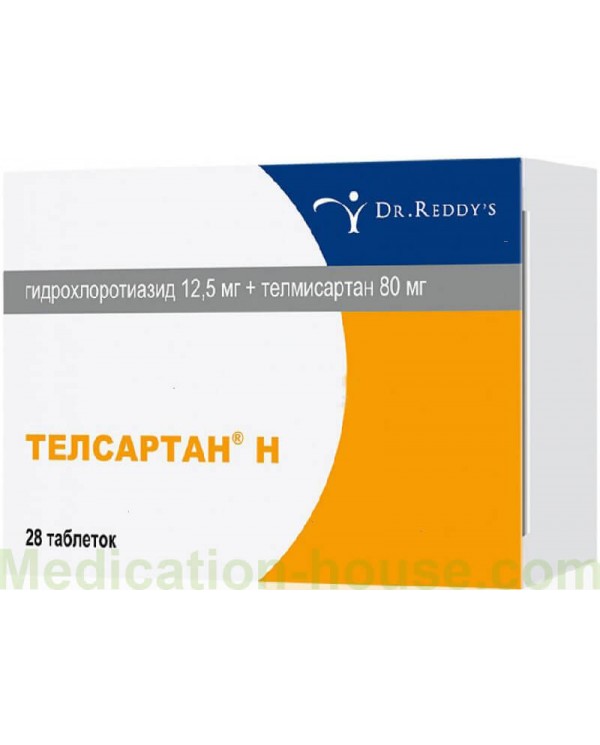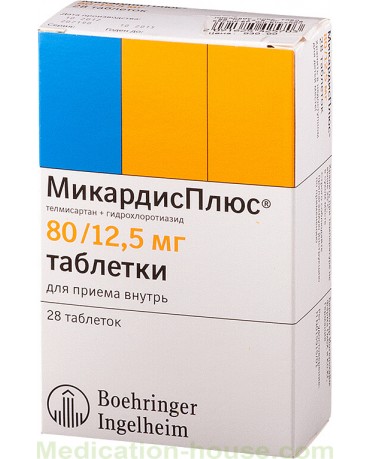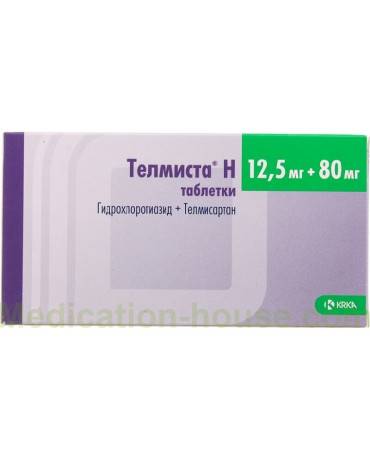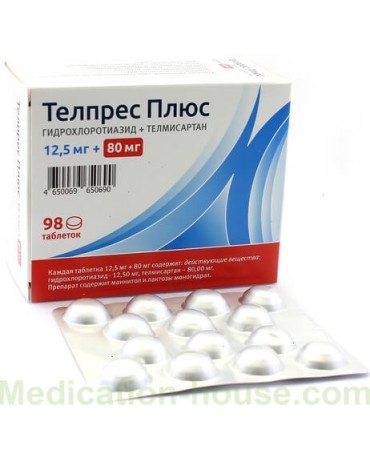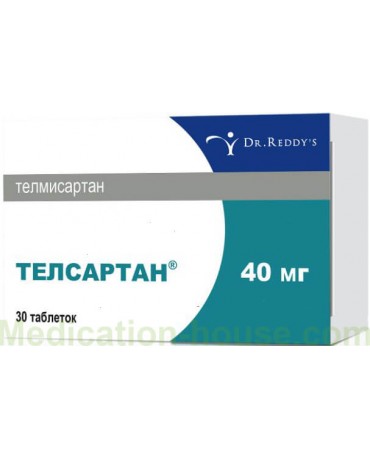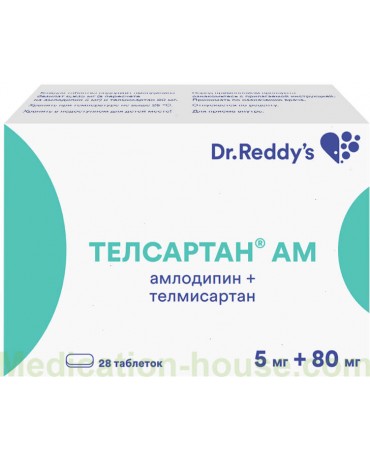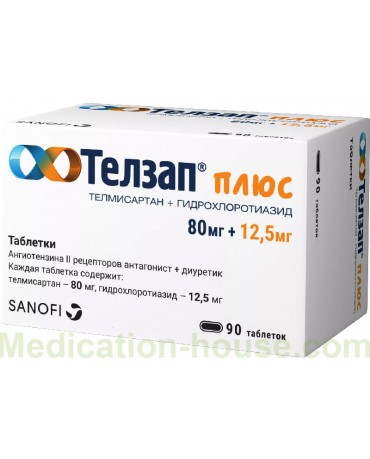User manual for Telsartan H
You can buy Telsartan H here
Release form
The medicine is presented in the form of tablets of 2 types: 40 mg / 12.5 mg and 80 mg / 12.5 mg. Let's take a closer look at the dosage of 40mg / 12.5mg. The substance is contained in a capsule. They are covered with two layers, which are painted in different colors. The first (top) color ranges from light pink to dark pink. The second (bottom) can be represented by different tones of white. The capsule has a standard oval shape. The bevel is applied - a beveled surface of a sharp edge, due to which the capsule is easy to swallow. There is a dividing strip on one side of the tablet. Both halves of the tablet are marked "T" and "L", made in the form of embossing. There is also a "40" image to indicate the dosage. As for the tablets with a dosage of 80 mg / 12.5 mg, they are no different in appearance from those already described. There are also two layers in pink and white. A similar cylinder shape with softened edges. To distinguish between tablets, you need to look closely at the print. Instead of 40, 80 will be indicated. In addition, you can navigate by size, those that are 80 mg slightly larger.
Structure
The composition includes the following components of Telsartan H: • Telmisartan (40 mg or 80 mg) - the main active ingredient; • Hydrochlorothiazide - 12.5 mg. The manufacturer indicates in the composition some excipients that are pharmacologically neutral, but improve the absorption of the main active substance, serve as a binder or are used as dyes.
Packaging
Telsartan H is available in a blister pack. There are two options for packs with two and four blisters. There are 7 tablets in one plate. Each of the packs contains 14 and 28 tablets, respectively. The tablets are sold in cardboard packaging, the kit includes instructions for the use of Telsartan H.
Pharmachologic effect
The action of telmisartan, like ARAII, is specific. The agent has similarities in basic properties with the subtype of AT1 receptors that activate the activity of the oligopeptide hormone - angiotensin II. Telmisartan acts on it by blocking interaction with receptors. However, the substance is not a receptor agonist. Telmisartan is quite selective. For example, it affects exclusively the specified group of receptors. A similar effect of the component with other species is not observed, but this phenomenon has not yet been sufficiently studied. Another property of Telsartan H is that telmisartan reduces the level of aldosterone in the blood. In this case, ion channels and renin in the blood plasma are not blocked. It does not inhibit this substance and kininase II (ACE). ACE is an enzyme that has a destructive effect on bradykinin. This minimizes the negative effects of bradykinin. The effect of telmisartan finally inhibits the activity of angiotensin II, which has a stable effect on the human body to reduce pressure. The onset of the effect is after 3 hours. The duration of the component is 24 hours, with a residual effect of up to 2 days. You can observe a steady decrease in blood pressure at maximum rates after 30 days of regular medication. Telsartan H does not affect the heart rate, so the pulse remains unchanged. Cancellation of telmisartan will restore blood pressure readings before taking the medication. Withdrawal syndrome is not seen, as well as other side effects. The second substance in the combined antihypertensive drug is hydrochlorothiazide. It is a thiazide diuretic. Its effectiveness is manifested in the prevention of reabsorption of ions of a number of minerals (magnesium, potassium, sodium, chlorine) and water, which occurs in the nephron - its distal part. A diuretic resists the elimination of uric acid and calcium ions. At normal blood pressure, the effect of the substance on the body is practically absent. The effect of hydrochlorothiazide begins after 2 hours, reaching maximum values after 3-6 hours. The substance has a prolonged action lasting 6-12 hours. A stable result (antihypertensive) appears after 3-4 days from the start of administration. The effect will last for another 7 days if you stop taking Telsartan H. In the event that the therapy is for a long time, then the maximum effect will be achieved with a lower dose of Telsartan H. The antihypertensive effect, manifested in the form of a decrease in blood pressure, is accompanied by the following reactions: • resistance in the vessels of the kidneys; • increased glomerular filtration; • activation of renin. Hydrochlorothiazide in high doses at one time reduces blood volume. Reduced blood flow in the renal vessels. However, all reactions are within the norm. Long-term therapy with a lower dosage affects the body in a different way. The plasma volume continues to be at the same level, but the glomerular filtration rate and volume in 1 minute come to the values before the start of the medication. At the same time, blood pressure (in average values) and resistance in the vessels are at a low level. It should be borne in mind that hydrochlorothiazide sometimes provokes the production of breast milk. The result of Telsartan H's action appears after 4-6 weeks. A high effect is achieved only with the combined use of telmisartan and hydrochlorothiazide.
Indications
Indications for use - high blood pressure. Telsartan H is used in cases where telmisartan or hydrochlorothiazide therapy, when taken separately, does not work.
Dosage
It is taken orally once a day, regardless of the meal. If the liver is impaired, the minimum dose is prescribed. If these standards are exceeded, an overdose is possible, the cases of which have not yet been identified. The symptomatology of this process can be the sum of the negative factors that appear as a result of taking an excessive amount of each of the components of Telsartan H.
Hydrochlorothiazide overdose
Symptoms: • arrhythmia; • reduction in blood volume in the vessels.
Telmisartan overdose
Symptoms: • hypotensive state; • bradycardia; • tachycardia. Overdose treatment: constant monitoring of serum creatinine levels. Therapy is symptomatic. Hemodialysis is ineffective because the elimination rate of hydrochlorothiazide has not been established.
Side effects
Side effects of Telsartan H affect many body systems. Respiratory organs may be affected due to the development of inflammation, shortness of breath, pulmonary edema, respiratory disorders. Due to damage to the nervous system, migraine, anxiety, depression, drowsiness, dizziness, insomnia, and fainting are possible. In some patients, bradycardia was noted due to changes in blood pressure. Most often, problems are observed in the gastrointestinal tract. It is associated with indigestion, constipation, decreased appetite, and anorexia. dry mouth, pain and vomiting. A link has been established between Telsartan H and hyperglycemia, pancreatitis, hepatic dysfunction, dyspepsia, and jaundice. There were complaints of increased sweating, problems with the musculoskeletal structure, blurred vision, glaucoma, myopia and xanthopsia, problems with potency. Blood counts after taking Telsartan H were noted as follows: • neutropenia; • decrease in platelets and leukocytes; • an increase in the level of eosinophils; • anemia. Less commonly, there are abnormalities in the work of the kidneys, glucosuria and nephritis. Problems in metabolism and development of infectious processes have been noticed. These include bronchitis, pharyngitis, other infections of the respiratory tract, sepsis, cystitis, other infectious pathological conditions of the urinary tract, infection of the salivary glands. Allergy manifestations intensify: • eczema; • erythema; • itchy skin, • rash; • angioedema; • vasculitis; • epidermal necrolysis; • lupus-like manifestations; • anaphylactic reactions; • manifestation of symptoms of photosensitivity. In addition, general weakness of the body, an increase in body temperature, a condition close to the flu may be noticeable.
Contraindications for use
Despite the effectiveness of Telsartan H, it cannot be used in some cases. Basically, when the general condition of the body is unable to tolerate side effects. Therefore, it is recommended to pay attention to a number of the following problems and avoid the use of Telsartan H: • with blockage of the bile ducts; • in case of functional disorders in the work of the kidneys (indicators within 30 ml / min); • if class C on the Child-Pugh scale was established during liver disease; • the concentration of calcium in the blood exceeds 3.0 mmol / l - hypokalemia. Also, malfunctions of Telsartan H were noticed when used simultaneously with the drug Aliskiren. Deterioration in health status occurred with diabetes mellitus and kidney failure. It is recommended to choose a different medicine for those people who have not reached the age of 18. If earlier there was a negative reaction to the constituent components of Telsartan H, then it should be abandoned. In case of the following problems, it is recommended to seek the advice of your doctor before starting therapy: • liver dysfunction or pathology - according to the Child-Pugh scale, class A and B (recall that in class C, use is prohibited); • liver dysfunction; • narrowing of the arteries of the kidneys; • a decrease in blood volume due to diuretics; • low salt intake; • vomiting, bowel upset.
Application during pregnancy and lactation
During the period of gestation and breastfeeding, Telsartan H should not be used. Studies concerning the effect of hydrochlorothiazide on the female body during the first trimester have not been conducted. It is known that hydrochlorothiazide has the ability to pass the placental barrier. The pharmacological properties of this substance suggest the following conclusion: its intake by pregnant women in the II and III trimester violates placental perfusion, and affects the development of the child, which leads to the following pathologies: • disorders of absorption and distribution of water and salts in the body; • jaundice; • thrombocytopenia. Hydrochlorothiazide is not recommended for pregnant women with chronic high blood pressure. An exception can be made only if all other methods of treatment have not brought the desired result. In this regard, doctors recommend that you stop taking the medication as soon as the first signs of pregnancy were discovered. After consultation with a doctor, analogues are selected that do not affect the development and health of the embryo and fetus. There is a wide range of drugs, of varying effectiveness, but not prohibited during the period of gestation. The same can be said about the postpartum period, when there is a need to feed the baby with breast milk. The negative effect of the drug was revealed as a result of experiments on animals. Experiments confirming the effect on the human body have not been performed.
Application for violations of liver function
The liver is the main organ involved in removing drugs from the body, so it is essential that it be completely healthy. Any lesions are a reason to stop taking Telsartan H. In some cases, for example, pathological disorders or progressive diseases, it is not necessary to completely avoid the medication. Reception is not prohibited, but there should be such a dosage that does not aggravate the violation of the water-electrolyte balance. If the processes of consumption and excretion of water and salt are disrupted even to a small extent, the patient faces serious consequences. A common case is hepatic coma.
Application for impaired renal function
Taking medication is contraindicated in the following conditions: • pathology in the work of the kidneys; • combined use with Aliskenen by patients with the following diagnosis: renal failure and diabetes mellitus; • hypokalemia. Renal failure is not a reason to refuse therapy with Telsartan H, but there are a number of conditions. First, you need constant monitoring by your doctor. Secondly, there is a need for regular measurement of potassium levels - if negative trends in indicators are noticed, drug therapy should be discontinued immediately. The same applies to observations of creatinine in the body. If the patient has had a kidney transplant, it is not recommended for him to use this medication. There were no clinical trials or observation of patients in such a situation.
Special instructions
Liver failure
In case of liver failure, the use of Telsartan H is not recommended. In particular, this concerns the blockage of the bile ducts and the decrease in the amount of bile that enters the duodenum. In addition, special attention is paid to the pathological conditions of the liver. Such attention is paid to these organs due to the fact that the drug is excreted through the intestines as part of bile. Therefore, in patients who have been diagnosed with even the mildest forms of liver dysfunction, the drug can greatly worsen the situation. In this regard, the dosage of the medicine is determined by the doctor, guided by the Child-Pugh scale.
Renal failure
Recall that Telsartan H strongly affects the water-electrolyte balance, that is, it can negatively affect the circulation of water and salts in the body. The kidneys play an important role in this process. After all, their main function is to remove water and regulate the acid level. Therefore, in case of serious disorders in the work of the kidneys, it is necessary to carefully approach the development of the dosage and carefully monitor the state of the body during therapy. For example, you can regularly donate blood for analysis to determine the concentration of potassium and creatinine. If there is a noticeable decrease, then it is necessary to complete the course. There are recommendations for taking more sparing pills after organ transplantation, since no precise data on the effect of the substance have been identified.
Renovascular hypertension
If the patient has increased pressure in the arteries of the kidneys, then taking the medicine can aggravate the pathology. This will lead to impaired renal function. The same will be observed with narrowing of the arteries in the kidney. It is worth noting that this problem is common to all angiotensin II receptor antagonists and it will be difficult to find a safe analogue.
Hypovolemia
One risk group includes patients who have decreased blood volume and those whose sodium levels in the body have dropped below 135 mmol / liter. For them, telmisartan will cause a drop in blood pressure after the first dose. The problems of hypovolemia and hyponatremia are often caused by the active use of diuretics, which lead to dehydration, which entails a number of problems with the gastrointestinal tract and an imbalance in the water-salt balance. All of these consequences can be corrected, which is recommended before starting to take Telsartan H.
RAAS
The RAAS is a hormonal system that regulates blood pressure and blood volume. There are several dangers awaiting patients with dysfunction of this system when taken simultaneously. "Double blockade". Angiotensin-converting enzyme (ACE), aliskiren and angiotensin II receptor antagonists, when taken simultaneously, pose the risk of the following serious conditions: 1. Arterial hypotension. 2. Hyperkalemia. 3. Dysfunction of the kidneys, up to and including their failure. Therefore, it is necessary to avoid cases of "double blockade" when the RAAS is simultaneously influenced by ACE inhibitors, angiotensin II receptor antagonists or aliskiren. In cases where there is an urgent need for such a combination, joint therapy takes place under the supervision of a doctor. Constantly monitored: • kidneys; • blood pressure; • electrolyte balance. Patients diagnosed with diabetic nephropathy should refrain from concomitant use of angiotensin II receptor antagonists and angiotensin-converting enzyme blockers.
RAAS activation
RAAS affects all organs, but this is especially evident in the kidneys and vascular tone. Examples include case histories of patients who have had various renal dysfunctions, heart failure, and renal artery stenosis. Therefore, drugs that affect the RAAS can become irritants for these organs and cause oliguria, hyperazotomy and arterial hypotension.
Diabetes
Telmisartan is not recommended for patients with diabetes mellitus who are taking insulin and hypoglycemic drugs. Combinations of drugs can lead to a deterioration in health, and provoke a decrease in blood glucose levels. Combining drugs is only possible if specialists regularly conduct blood tests and monitor blood sugar levels. There is also a need for constant adjustment of the dose of all drugs taken.
Hyperaldosteronism
When a patient is diagnosed with an elevated level of aldosterone secreted by the adrenal cortex, he should not take the medication. This is due to the fact that all the active substances of Telsartan H are blocked and do not fulfill their function.
Cardiac pathology
Caution when taking the substance should be shown to people with stenosis of the mitral and aortic valves, as well as with hypertrophic obstructive cardiomyopathy.
Hyperkalemia
Hyperkalemia is a condition where a patient has an increased serum potassium level. This condition can be caused by a number of factors. One of them is the use of drugs that affect the RAAS. In particular, this applies to the specified funds. In addition to it, the condition can be aggravated by: • potassium preparations; • salt substitutes; • potassium-sparing diuretics; • immunosuppressive drugs; • non-steroidal anti-inflammatory substances; • COX-2 blockers. Also, diseases such as diabetes mellitus, kidney and liver pathologies, necrosis, ischemia affect hyperkalemia. All of these conditions can be aggravated while taking the medication. Therefore, people at risk should be especially careful and constantly check their blood for serum potassium concentration. The risk group includes elderly patients, that is, those who have reached 70 years of age. There are special instructions for patients with reduced blood pressure due to brain diseases. These include damage to the cerebral vessels and coronary heart disease. With these symptoms, taking the drug can cause stroke and myocardial infarction.
Effect of Telsartan H by race
The drug is suitable for representatives of all races, but there is still a difference in the degree of action of the drug on the body. All drugs that affect the RAAS cause an antihypertensive reaction in people of the Negroid race. This is the influence of hyporeninemia, which accompanies arterial hypertension in people of the Negroid race.
Potentially hazardous situations
It should be remembered that the substance causes drowsiness and dizziness. Other side effects associated with high blood pressure therapy are also possible. In this regard, potentially dangerous situations can arise while driving, as well as in conditions where increased concentration of attention is required. In this regard, it is necessary to take the medicine with caution and avoid these situations.
Drug interactions
It should be borne in mind that the medicine cannot be taken simultaneously with some medicines. These include Ramipril and its form, Ramiprilat. It has been proven that they increase the concentration of the active substance in the blood by almost 2.5 times, which leads to an increased decrease in blood pressure. It has not yet been established how clinically significant this is. However, there have been studies that have shown that abrupt cessation of both drugs led to arterial hypotension (a critical drop in blood pressure). There have also been cases of severe cough and angioedema (allergic reaction). In addition, a combination of dosage forms can cause a number of pathologies: • periodic disturbance of blood flow in the brain (syncope); • short-term fainting; • significant decrease in blood pressure; • renal failure. The combined administration of lithium preparations and angiotensin II receptor antagonists must be combined with the control of the level of the element in the blood plasma. With the use of ACE inhibitors, a serious increase in the concentration of lithium is possible. As a result - intoxication of the body. Non-steroidal anti-inflammatory drugs of general and selective action and blockers of cyclooxygenase-2 can adversely affect the condition of a patient in whom the volume of circulating blood is reduced. Together, the drugs can be taken as a therapy against inflammatory processes. Medicines that affect the RAAS are able to act on the body with a synergistic effect. When carrying out therapy, which includes Telmisartan and NSAIDs, it is recommended to carry out procedures to compensate for the BCC. It is necessary to constantly monitor the work of the kidneys. The simultaneous reception of telmisartan and NSAIDs blocks the process of vasodilatation, as a result of the work of prostaglandins. No clinically significant changes were observed when used with the following dosage forms: • Amlodipine; • Simvastatin; • Glibenclamide; • Warfarin; • hydrochlorothiazide; With the combined administration of Telmisartan N and Digoxin, the level of the latter in the blood plasma increases. It is necessary to monitor this parameter by donating blood for a clinical analysis. There is evidence, supported by research, that with a double blockade of the RAAS with the help of Aliskiren, angiotensin-converting enzyme inhibitors or angiotensin II receptor blockers, patients develop negative symptoms. These include: • lowering blood pressure; • renal dysfunction, which can lead to kidney failure; • an excess of potassium in the blood. In the case of using a single RAAS inhibitor, the above conditions are less common. When using the drug with narcotic analgesics, barbiturate and ethanol, there is an increased risk of orthostatic hypotension caused by a deficiency of blood in the vessels of the brain. The joint use of the drug with insulin or hypoglycemic drugs taken by mouth, in certain cases, requires a corresponding adjustment of their doses.
Metformin in combination therapy can lead to lactic acidosis, and Colestipol or Kolestyramine - to a deterioration in the metabolism of hydrochlorothiazide. In the latter case, the absorption process is disrupted due to the presence of exchangeable anionic resins in the blood. Interaction with cardiac glycosides in some cases leads to arrhythmias. Rarely risk of hypomagnesemia or hypokalemia. The processes are caused by the intake of thiazide diuretics. Taking the medication together with pressor amines such as norepinephrine can reduce the effectiveness of the latter. Hydrochlorothiazide, when combined with tubokurin chloride, as well as other non-depolarizing muscle relaxants, increases their effect on the body. Anti-gout drugs affect the rise in serum uric acid. In such cases, an adjustment of the doses of this agent is required. Addopurinol and thiazide diuretics - this interaction increases sensitivity to addopurinol. Also, thiazide diuretics with joint vitamin therapy accelerate the growth of calcium levels. This is due to increased stress on the kidneys. Thiazide diuretics and beta-blockers, as well as diazoxide - hyperglycemia is possible. It is caused by beta-blockers and diazoxide. In combination with atropine, biperidine and other M-cholinergic blockers, the absorption efficiency of thiazide diuretics is enhanced. The rate of excretion of Amantadine may decrease while taking it with hydrochlorothiazide. As a result, the substance accumulates in the body, which is toxic. Methotrexate, cyclophosphamide and other cytotoxic drugs, when taken together with the drug, show a more pronounced effect than when taken separately. Non-steroidal anti-inflammatory drugs taken by patients with thiazide diuretics can reduce the effectiveness of therapy and lead to a decrease in antihypertensive and diuretic results. There are drugs that, when combined with hydrochlorothiazide, increase the risk of increased hypokalemia. These include: • diuretics designed to remove potassium; • calcitonin; • laxatives; • licorice root and other preparations containing glycyrrhizated acid; • ACTH (adrenocorticotropic hormone); • carbenoxolone; • amphotericin B; • benzylpenicillin. Telmisartan is used to compensate for potassium deficiency. It has the ability to conserve potassium. Thiazide diuretics most often provoke arrhythmias caused by high potassium levels in the body. The joint use of the medicine with Theophylline can lead to increased potassium levels. The combination of thiazide diuretics and amiodarone increases the risk of arrhythmia. It is directly related to hypokalemia, the likelihood of which increases with the intake of: • diuretics that preserve potassium; • preparations containing potassium; • potassium salts (when replacing the sodium salt). When taking the drug with drugs that cause hypokalemia, it is necessary to do a blood test and monitor the indicators.
Terms and conditions of storage
The drug does not need specific storage conditions. It is only necessary to maintain the temperature up to 25C and dryness in the room. Also make sure that children do not have access to the storage area. Do not store for more than two years and do not take after the expiration date.
Testimonials
It turned out to be quite difficult to find reviews about the drug, since the drug has a specific purpose and is used in narrow circles. However, those visitors who have experienced the effect on themselves note the effectiveness of the drug, which helped to quickly solve problems with blood pressure. As for the comments of doctors and specialists, they warn you to carefully read the side effects before taking. You also need to monitor safety during therapy.
Terms of sell
You don't need a prescription to buy Telsartan H.

